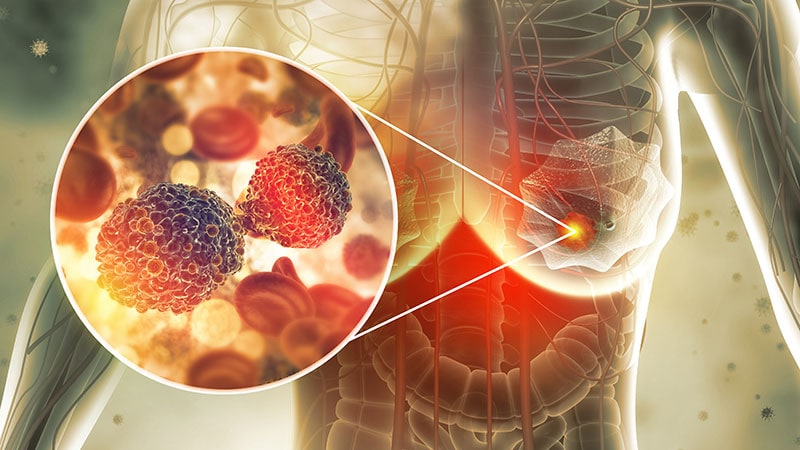What’s the optimal duration of extended endocrine therapy for postmenopausal women with hormone receptor (HR)–positive breast cancer?
The IDEAL trial, published in 2017, provided initial clarity: women did not experience a benefit from 5 years of extended adjuvant letrozole compared with 2.5 years. The findings suggested that these patients could safely receive extended endocrine therapy for half as long.
However, more recent data indicate that certain patients may still benefit from 5 years of extended endocrine therapy, and a genomic test can help identify those patients.
The 70-gene MammaPrint test, which classifies a person’s risk of distant metastasis, found that patients deemed low risk showed a significant benefit from 5 years of extended therapy while those considered ultra-low or higher risk did just as well with 2.5 years of extended therapy.
“Our results show that MammaPrint is predictive of extended endocrine therapy benefit,” said co-author Laura van’t Veer, PhD, inventor of MammaPrint and a professor in the Department of Surgery, University of San Francisco, during a presentation at the San Antonio Breast Cancer Symposium (SABCS) 2022. The data indicate that higher-risk and ultra-low-risk patients can avoid potential overtreatment, while low-risk patients appear to have better outcomes from 5 years of extended endocrine therapy, van’t Veer concluded.
Patients with HR-positive, early-stage breast cancer carry a high risk for late recurrence, and randomized trials have shown disease-free survival benefits by extending adjuvant tamoxifen or aromatase inhibitor therapy for an additional 5 years beyond the initial 5 years of treatment.
However, recent studies have challenged those findings. Those studies found that for some patients, 5 years of extended therapy provided no greater benefit compared with 2.5 years, suggesting many patients may be receiving too much endocrine therapy. Notably, the phase 3, prospective IDEAL trial found that for women who received letrozole extended therapy for 5 years or 2.5 years, rates of disease-free survival events were similar (hazard ratio [HR], 0.92; 95% CI, 0.74 – 1.16), as were overall survival (HR, 1.04; 95% CI, 0.78 – 1.38) and distant metastasis-free interval (HR, 1.06; 95% CI, 0.78 – 1.45).
However, certain subgroups may still benefit from a longer course of extended therapy. Data from the NSABP B42 trial, published last year, revealed that the MammaPrint test predicted a statistically significant absolute benefit from extended endocrine therapy for patients with lower-risk disease, and this benefit appeared to be stronger for those with low- vs ultra-low-risk disease.
To determine whether MammaPrint could further stratify outcomes among lower-risk patients, van’t Veer and colleagues identified 515 patients in the IDEAL trial who had not experienced a disease recurrence event after 2.5 years of extended therapy and for whom MammaPrint test results were available.
All patients had initially been treated for 5 years with either tamoxifen monotherapy, tamoxifen followed by an aromatase inhibitor, or aromatase inhibitor monotherapy. The 515 patients with MammaPrint results had clinical characteristics that were comparable to those of the entire cohort.
Over a median follow-up of 10.5 years since extended therapy began, patients with low-risk tumors demonstrated significantly better outcomes with 5 years of extended endocrine therapy compared with 2.5 years — 10% improvement for distant recurrence (HR, 0.32), nearly 12% for recurrence-free interval (HR, 0.35), and almost 10% for breast cancer–free interval (HR, 0.48).
However, patients with ultra-low or high-risk tumors showed no such benefits with 5 years of extended therapy.
Putting the results into context, van’t Veer noted that it makes sense that those with low-risk disease would benefit from a longer course of extended endocrine therapy, given that this group “is known to have late recurrence risk, after 5 years.” Those with ultra-low-risk tumors, on the other hand, have such low risk of recurrence that prolonged treatment has no benefit, while those with higher-risk disease typically experience recurrence sooner, before 5 years, she said.
Generally, the data “suggest that 7 to 8 years of endocrine therapy may be adequate compared to 10 years,” but broader conclusions are limited by some gaps in understanding, Terry Mamounas, MD, MPH, the first author on the NSABP-B42 trial, told Medscape Medical News. For instance, “we cannot be definitive about [the duration of extended therapy] in patients who receive extended tamoxifen after 5 years of tamoxifen, where we only have data with 5 additional years.”
Additionally, MammaPrint may not be the only test that can help identify subgroups of patients who may benefit from 5 years of extended therapy. Recent data suggest that the Breast Cancer Index (BCI) could be another tool. In an IDEAL trial analysis, the BCI ratio of HOXB13/IL17BR (H/I), a gene expression–based signature, was predictive of a benefit from 5 years vs 2.5 years of extended endocrine therapy among patients with a high vs low BCI H/I ratio.
Ultimately, “more evidence is needed to solidify the existing findings and identify new prognostic biomarkers and biomarkers that better predict benefit from extended endocrine therapy,” said Mamounas, of Orlando Health Cancer Institute, Florida.
Van’t Veer is the inventor of MammaPrint and owns stock in Agendia; she is also a consultant for ExaiBio. Mamounas has relationships with Genentech/Roche, Exact Sciences, Merck, Biotheranostics, Genzyme-Sanofi, and Tersera.
San Antonio Breast Cancer Symposium (SABCS) 2022: Presented December 9, 2022.
For more news, follow Medscape on Facebook, Twitter, Instagram, and YouTube.
Source: Read Full Article
